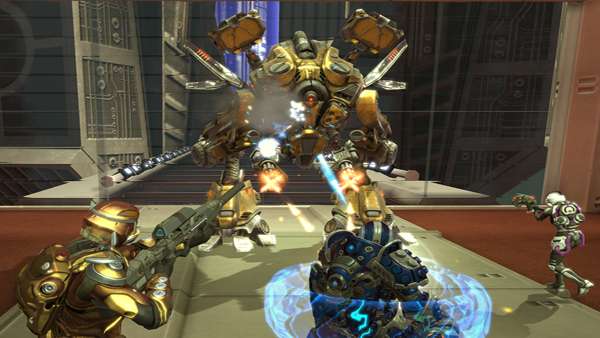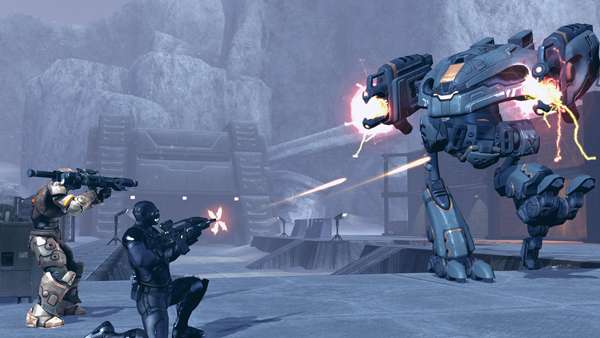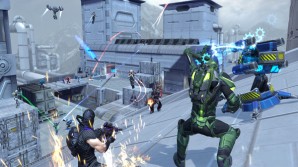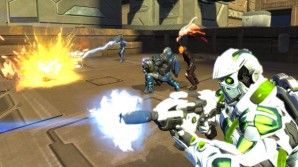Global Agenda PC Review

In a market almost dominated by Blizzard’s World of Warcraft, creating a new MMO is always a huge risk. Creating an MMO/shooter hybrid is even riskier, especially with so many online populated titles with one-time purchasing fees. Whether a sign of strong confidence or a severe misstep, Hi-Rez Studios have decided to make their debut into gaming with Global Agenda, a massive multiplayer online third-person shooter with territorial battles and co-operative mission play.
Strange how none of that sounds terribly original in this day and age. But fees aside, is this newest online opus worth your time?
The plot of Global Agenda’s sci-fi setting (or as the developers call it, “sci-spy”) takes place in 22nd-centruy Earth. In the wake of a global disaster, a government superpower known as the Commonwealth rules the world with low taxes, a bustling economy, and an affordable healthcare plan. No, I’m kidding, it’s actually a tyrannical dictatorship that abuses its power and seeks to take over all available land (because in the future, there isn’t much land left to live on). During this war for hospitality, your created character awakens from a hibernation tube, immediately given instructions to escape and shoot down the clearly evil robotic guards.

If the opening tutorial sounds oddly similar to a certain RPG epic barely two months old, then the fact that this game also runs on the Unreal Engine probably doesn’t help things. Regardless, the opening backdrop is just a primer to get players accustomed to the controls, and it serves its purpose. One required boss fight (played by Dragon Ball Z voice actor Chris Sabat, of all people) later, and you’ll find yourself whisked to the rebel base, which also serves as the main hub of Global Agenda. From here you can choose which missions to engage in, be it co-op or PvP, as well as visit shops where you can upgrade your gear and customise your character even further.
The gameplay is familiar, even for those who haven’t dabbled much with MMOs. You gain experience points and levels by defeating enemies, with points that can be attributed to extra skills, skill slots, and other improvements to your combat repertoire. These include different types of explosive grenades, a forcefield that repels most incoming fire, or a device that slowly replenishes health. In addition, players are also outfitted with a jetpack that allows for a brief but rather satisfying burst of flight, perfect for those hard-to-reach areas as well as showing off for those memorable multiplayer kills. But the real diversity comes in the character classes, which include Assault (the heavy weapons guy), Medic (take a guess), Recon (Scout) and Robotics (Engineer).
The connections to WoW can be felt in nearly every new MMO, but the biggest similarity comes from Valve’s beloved Team Fortress 2. The four selectable classes play similarly to TF2’s roster, and even pair up the same way (Medic works as a healing companion for the tank-like Assault class, for example). In theory this would be a positive thing, considering the massive popularity of Valve’s kill-or-be-killed multiplayer title, but this also brings up the ultimate question on many people’s minds: why pay a subscription for Global Agenda when Team Fortress 2 (and its subsequent updates) remain free?
In actuality, playing Global Agenda’s online multiplayer is free in itself; the monthly fee actually goes toward a premium service, named the Conquest Package. Paying for this package nets players with all the up-to-date updates along with a higher level cap and the ability to play a part in the ongoing territory battles. The premium content also allows a more flexible management of fellow agencies (also known as clans), including the ability to schedule missions together as well as more advanced text and voice chat features. But most importantly, subscribing to the Conquest Package makes players eligible for all subsequent player-vs-player events as they become updated.

Put simply, putting a price on subsequent content is Global Agenda’s biggest flaw. Team Fortress 2 continues to bust out new events, items, weapons, and other content for free even years after its release. What Global Agenda does have in its favor, though, is the larger-scale battles where more players can fill the screen at once, as well as the mission-based co-op that has teams working together to take down a swarm of AI goons. There’s also the standard MMO looting to be found with an endless supply of equipment and items to purchase, as well as an auction house that will no doubt become the obsession for players looking to spend (or earn) tons of online currency.
Whether or not Global Agenda is worth paying a monthly fee for entirely depends on the player, along with Hi-Rez Studios’ commitment to pump out enough updates that justify the fees. There’s nothing fundamentally wrong with the game, but there’s nothing particularly outstanding about it either. The combat is versatile, the graphics are decent (but hardly reach the level of that “other” sci-fi game running on Unreal Engine), and the free-to-play missions are quick but ultimately satisfying. But for players looking for extra content in the long run, ponying up for the subscription will become an eventuality, and ultimately becomes their decision to make.


